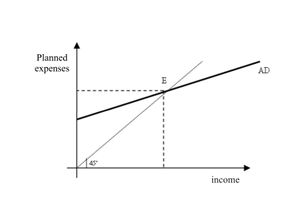Global demand
| Global demand |
|---|
| See also |
Global demand is the key category in macro-economics. Global demand or total demand refers to amount of money, which the subjects of economy plan to spend on goods and services at the different size of income (or in other word - at given prices) in given period. In literature a shortcut - AD (aggregate demand) is used very often.
Total demand consists of:
- personal consumption expenditures
- gross private domestic investment
- gross government spending
- net export.
There are three subjects in economy: households, business companies and the government, which expenses are marked in literature with symbols:
C - Consumption,
I - Investment,
G - government spending.
Net export is a separate category (NX - Net eXport) and represents difference between national and foreign subjects expenses - NX = X - Im.
Description
The economy's equilibrium level is established as a result of the game of global demand and global supply in market economy. It means that the national product and level of prices are shaped on the level on which buyer's are willing to buy what enterprises are ready to sell. Equilibrium in real economies is seldom achieved and more often economies are not in this fixed point.
Curve of global demand
The aggregate demand curve shows how many goods and services all subjects of economy can purchase at different total level of prices. It shows movement along the curve of global demand (ceteris paribus). In different case, the curve AD moves to the right (the profitable changes) or to the left (the unfavorable changes) depending on the evaluation in assessing the future path of demand (optimism or pessimism), the policy of government and central bank (the taxes, interest rate), as well as economic situation abroad (the change of profitability of export and import, the fluctuations of currency rate). It is connected with the fact that the size of purchases made by individual economic subjects influences prices and the power of external elements.
Curve has minus slope (negative) what means that the size of global demand changes the level of prices inversely. The angle of slope (of curve of global demand) depends on the strength of the reaction in change of interest rate in dependence from changes of money supply, strength of reaction of change investment expenses depends on change of interest rate, degree of changes of consumptive expenses depends on change in level of wealth, as well as from degree of change of the transactional demand on money in relation to change of national income. Therefore, crucial factor is the elasticity of global demand in relation to interest rates or level of global wealth.
Equilibrium on market of goods
Essential matter joined with global demand is defined equilibrium on market of goods. In a short period at fixed prices and pays (wages and salaries), equilibrium is the moment when planned global expenses (global demand) are in fact equal production. The drawing below is illustration of this problem.
In order to qualify long-term equilibrium on market of goods we have to include in analysis changes of prices and payments. Mechanism of establishing the equilibrium in such an incident takes into account global supply what is the subject of separate article.
See also:
References
- Malmberg, A., & Power, D. (2005). On the role of global demand in local innovation processes. In Rethinking regional innovation and change (p. 273-290). Springer New York.
Author: Piotr Gawlewicz

